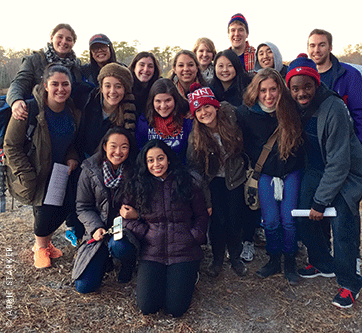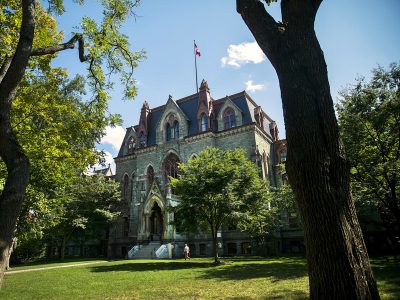
They’ve cleaned coral reefs in Key West, advocated for migrant farm workers in Texas, and restored trails in the Grand Canyon. They’ve worked in homeless shelters, counseled refugees, and built houses just about everywhere: New Orleans, Washington State, the Carolinas, Appalachia. The work isn’t always glamorous—pulling weeds out of an Everglades marsh, smearing tar on a steamy Florida roof—but that’s not the point.
When classes pause for spring break this year, 125 undergrads will scatter to service sites across the country. About half of them will build houses on Habitat for Humanity sites. The others will focus on environmental and social-justice causes. Now a 25-year-old tradition at Penn, Alternate Spring Break has sent more than 2,000 students on weeklong service trips since 1990.
It was on one of those trips, three years ago, that current College senior Kira Simon found herself crawling under a house in Lexington, Va., to install insulation.
“I knew I didn’t want to be sitting on the couch at home or drinking excessively over spring break, so I thought I’d just apply for ASB and see what happened,” she says. Simon liked it so much that she led a trip to the Everglades the following spring, then another to North Carolina. Now she’s co-director of the ASB student board.
“It’s a very intuitive program—it makes sense in terms of service,” says Loren Kole C’14, who spent three years on the ASB board and went on four spring break trips. “You go in, you work, you leave, you’re done. That’s very convenient for people who want to volunteer, but maybe have five hours total of free time during the school year.”
“It strikes a perfect balance between a stretch and a realistic commitment,” adds Andrea Gregor McGlynn Nu’94. “Students crave novel adventure, and this is a very doable one.” McGlynn would know. She created ASB with two friends—Pamela Urueta C’93 L’96 and Kathleen Sullivan C’93—back in 1990.
They first met at a Penn conference on hunger and homelessness. When they chatted during a breakout session, somehow the idea of an alternative spring break arose. The trips had been popping up at other schools but hadn’t yet reached Penn. McGlynn and her co-conspirators put up fliers, combed through applications, and by the spring of 1991, the first two ASB trips were headed to sites in Mexico and North Philadelphia.
“I think there were Penn students who had been looking for this type of opportunity,” McGlynn says. “It filled a gap in the student experience.” Her Philly-bound group lived in the old convent space of a Catholic church at night and worked on a Habitat for Humanity renovation site during the day. “It was snowy, it was cold, and we worked really hard,” she says.
The settings and cast change every year, but the template McGlynn helped establish 25 years ago is still much the same: a week-long, student-led trip that blends service and immersion.
“We were very clear in our intention for ASB to be an immersive experience—for it to involve living in a community with a high proportion of low-income residents and understanding the issues of that community,” McGlynn says. “College is an immersion itself, so I guess you could say ASB is like an immersion within an immersion.”
It has meant something different to each ASBer. For some it’s living in a gymnasium in Columbus, Ga. For others it’s volunteering on a Navajo reservation in Arizona, or meeting the grateful woman whose house they were building in Virginia.
While the service itself is certainly important, alumni say the trip is even more about who they’re with than what they’re doing. It’s about random conversations, van sing-alongs, planning and cooking big group dinners.
When Simon and her group went to the Everglades two years ago, they spent a whole day yanking up invasive weeds. They sang Backstreet Boys songs and talked about everything from sexual identity and feminism to Kurt Vonnegut novels.
As is usually the case, most people in Simon’s group had never met until that trip. She says the student-run board tries to throw strangers together, spanning all four undergraduate schools and class years when it rosters a trip. “The majority of my friends from ASB trips I never would have met without ASB,” she adds.
Kole says that the board purposely splits up groups, friends, and couples who ask to go on trips together. “The point is to meet new people,” she adds. “You get a slice of all different types of people at Penn that all care about doing something worthwhile over their spring breaks—people with core values that are shared, but really not much else. Learning that those people can become some of your best friends is a real joy.”
Though Civic House provides staff support and meeting space, ASB is “truly a student-led organization,” according to Civic House director David Grossman Gr’04. He says most alternative breaks bring along a staff or faculty member to supervise. Not ASB. Civic House staffers are only a phone call away, but generally the students solve their own crises, he says.
Students also manage the selection process, shuffling through more than 200 applications a year and turning away about half of ASB hopefuls. They fundraise, too—everything from Quizzo nights to selling pizza slices in their dorms—and secure funding from the Student Activities Council.
That money helps subsidize the costs of the trips. According to Megan Forman, Civic House’s associate director, students pay about half of what the trips actually cost. Some pay significantly less.
“No one is ever turned down from a trip for financial reasons,” Kole says. The ASB board awarded up to $8,000 in financial aid each year during her tenure. “I think that’s an important part of the mission. It’s one of the things that made trips so incredible and diverse.”
From searching for food during a blizzard and blackout in Lexington, to working on a house in Almost Heaven, West Virginia, Kole says she “wouldn’t have known half of the things I do about myself if it weren’t for ASB … It’s so easy to get into our own worlds at Penn, to just fixate on the classes you take and the clubs you join. It’s a lot of fun to have seven days to divorce yourself from that and find new people to care about.”
And with that, she went back to planning a brunch reunion for the ASB group she led in Virginia her senior year.
—Molly Petrilla C’06




